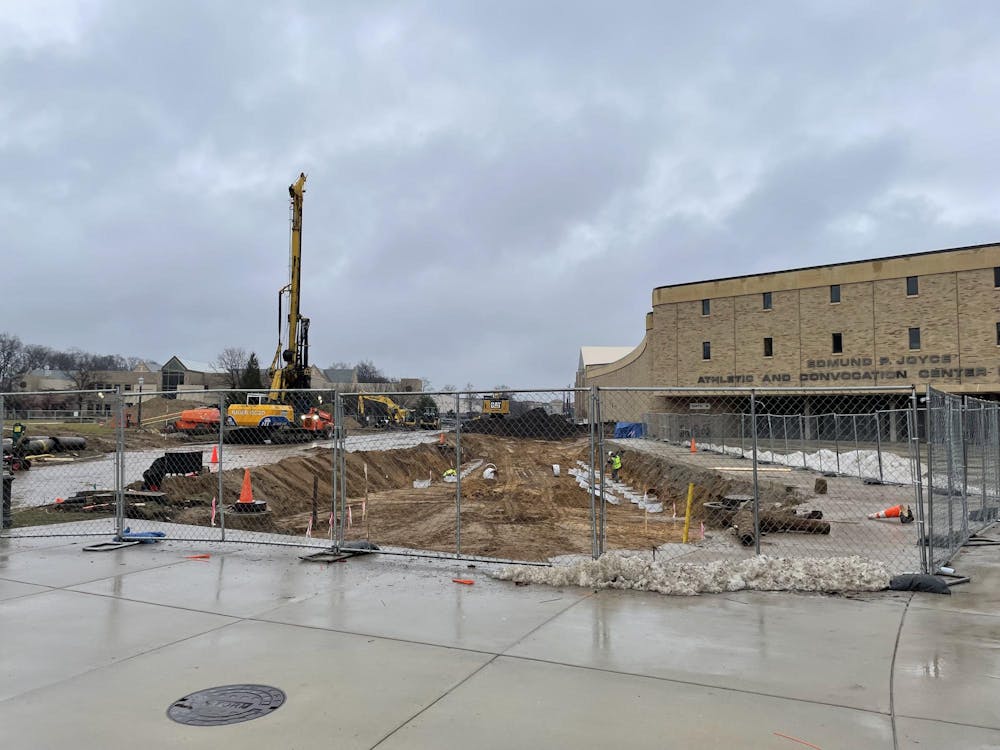Since returning to Notre Dame, students living to the east of campus will likely have noticed a new construction site adjacent to the Joyce Center and the Jordan Hall of Science, blocking part of Dorr Road.
In an interview with The Observer, University vice president for utilities and maintenance, Paul Kempf, explained a new geothermal plant is being built on the site to help power the geothermal well field being constructed in the parking lot between Notre Dame Stadium and Compton Family Ice Arena.
The construction is the latest stage in the University-wide geothermal energy project. The initiative began in 2017 with the construction of the east geothermal well field on the grassy area by McCourtney Hall.
“That was an effort to get us sort of familiar with geothermal and our engineers to get involved and get our hands on a smaller scale project,” Kempf said.
After this pilot project, a geothermal well field was built under the Notre Dame Stadium parking lot during the 2017 “Crossroads” construction project which expanded Notre Dame Stadium. The plant — which houses much of the machinery for the well field — was installed in the basement of the Walsh Family Hall of Architecture, south of the parking lot.
From here, another well field was installed underneath Ricci Family Fields, with the plant being built east of there.
The new plant being constructed by the Joyce Center will be completed by the end of 2025, Kempf said. Another well field will be constructed south of McCourtney Hall this summer.
Because the earth is generally a constant temperature, Kempf explained, geothermal wells can cool water in the summer and heat it up in the winter by circulating it underground.
“There’s two products of a geothermal system. You’re either going to get heating hot water, water that’s nominally 120 degrees used for heating, or you’re going to get chilled water, which is water that typically is in the 40 degree range,” he said.
Kempf noted that geothermal energy, by using the earth as a natural heater, is far more efficient than heating water via steam. While many older buildings still use steam water heating, most newer buildings now get their hot water from geothermal energy. These include McCourtney Hall, Dunne Hall, Flaherty Hall, Johnson Family Hall, the Walsh Family Hall of Architecture, the Raclin Murphy Museum of Art and the new men’s residence hall currently being constructed.
By using these more efficient heating systems, Kempf said, Notre Dame will be better able to reach its climate goals. In September 2021, University President Fr. John Jenkins committed the University to achieving carbon neutrality by 2050 and reducing carbon dioxide levels from their 2005 levels by 65% by 2030.
In addition to the geothermal wells, Notre Dame operates a hydroelectric dam on the St. Joseph River. A field of solar panels adjacent to SR 933 on the west side of campus was also announced in March 2023. Kempf acknowledged that construction on the field has been delayed due to supply chain issues, but that it should be completed within a year.
Notre Dame also has two wind turbines north of campus at the White Field Wind Tunnel Facility which were installed as a part of a research project by the College of Engineering; however, Kempf explained the turbines have not been operational in years and do not provide any energy to the campus.
The remainder of Notre Dame’s energy comes from the power plant on the north side of campus which burns natural gas. The plant stopped burning coal in 2019.
While Kempf said he did not know precisely how much energy at Notre Dame comes from renewable sources, he estimated that it is around 20% and makes up a growing portion of the total energy. Kempf stressed that Notre Dame is more focused on reducing carbon emissions overall, rather than reaching a specific percentage of renewable energy.
“Whatever we do that can reduce carbon emissions is really most important,” he said. “We do that by conservation, we do that by efficiency, we do that by changing fuels, we do that by changing technologies. All those things can contribute to carbon reductions.”
Kempf said he is optimistic that Notre Dame will reach its climate goals .
“Hopefully we can get there,” he said. “We certainly have projects slated and ideas of how to get there and we’re working on that constantly. We’re looking for technologies that will improve and give us better opportunities.”










